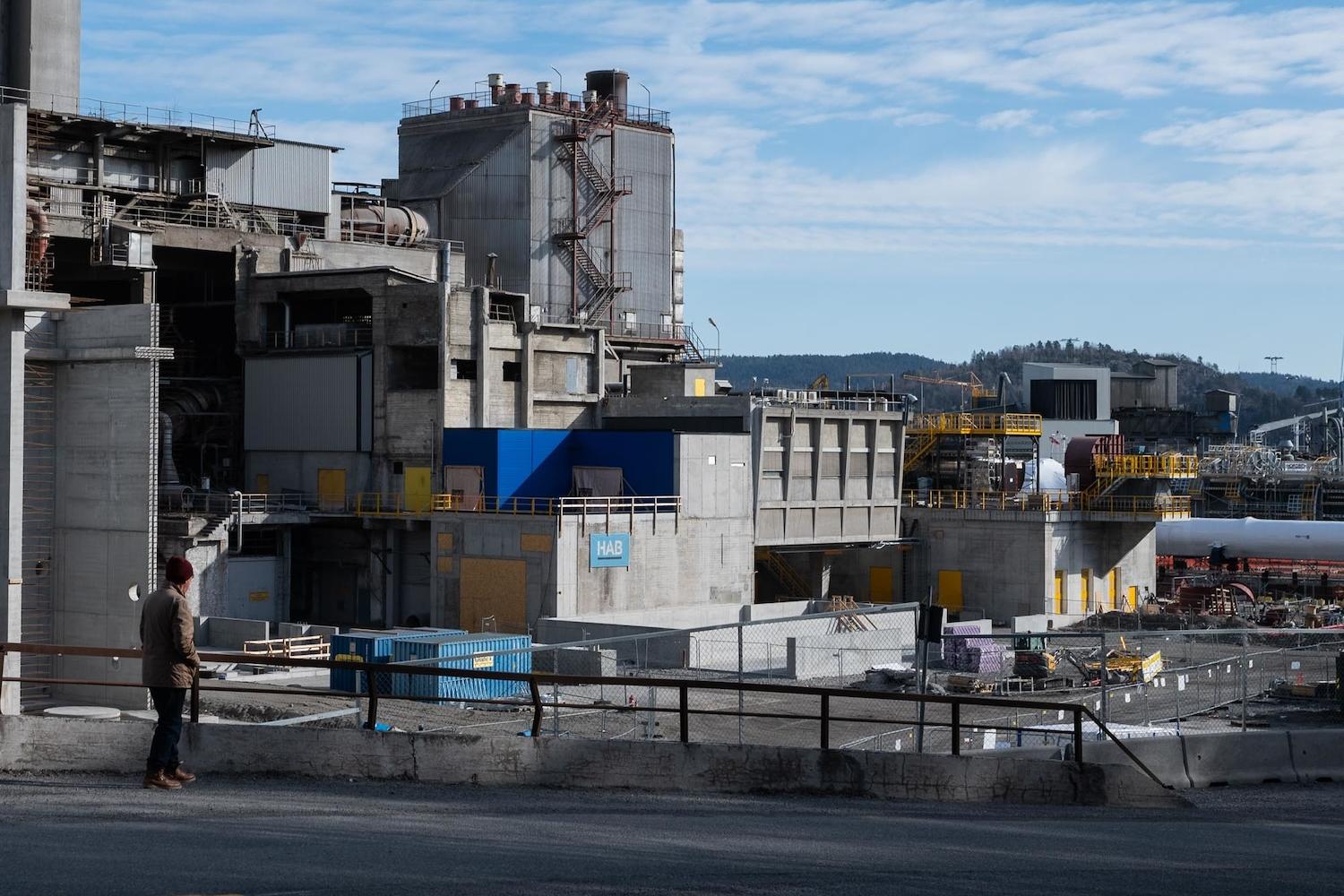
The HeidelbergCement Norcem plant in Brevik, Norway, became home to the world's first carbon capture system for the cement industry earlier this year. (Image: Astrid Westvang/Flickr)
The COP28 climate talks cast new attention on carbon capture and sequestration (CCS) strategies. Advocates point out that the Earth's natural sequestration systems are already overburdened, and some argue that large-scale, underground carbon sequestration facilities are needed to draw excess carbon dioxide from the air. However, their case is being undermined by others who advocate for new carbon sequestration technologies, including strategies that enhance the ability of nature to absorb excess carbon.
The case for carbon capture and sequestration
Advocates for carbon capture and sequestration point to the simplicity, scale, long duration and reliability of the technology. ExxonMobil, for example, describes CCS as systems to capture carbon dioxide that “otherwise would be released into the atmosphere, and injecting it into geologic formations deep underground for safe, secure and permanent storage.” The company further claims the technology is "readily available" and "can significantly reduce emissions from sectors like refining, chemicals, cement, steel and power generation."
That reference to “geologic formations” is a bit disingenuous, though. In North America, for example, captured carbon is likely to be injected underground for the purpose of extracting more oil from mature wells. On November 2, ExxonMobil increased its position in the enhanced oil extraction industry when it announced the acquisition of the firm Denbury.
The case against carbon capture and sequestration
Aside from its proven deployment in enhanced oil recovery, the case for carbon capture and sequestration is a shaky one on economic grounds. Critics argue that it is expensive compared to replacing fossil fuels with renewable resources. Instead of applying CCS to power plant emissions, they argue the technology should be reserved for heavy industries where the application of renewable energy is impractical.
A working paper published on December 4 by researchers at the Smith School of Enterprise and the Environment of Oxford University makes the economic case against carbon capture and sequestration for power plants. The authors note that the cost of CCS has not declined “at all” in 40 years, and it is not expected to decline significantly in the future.
That’s a sharp contrast with the cost of wind and solar power. Both plummeted in roughly the same period, and both are expected to continue declining in the coming years.
“Relying on mass deployment of CCS to facilitate high ongoing use of fossil fuels would cost society around a trillion dollars extra each year — it would be highly economically damaging,” said Rupert Way, honorary research associate at Smith.
Here in the U.S., the economic case against carbon capture for power plant emissions has been underscored by the FutureGen CCS project. Aimed at capturing and sequestering carbon emissions from a coal power plant in Illinois, FutureGen was announced in 2003 as a model for others to follow. The project was canceled in 2015 after private investors failed to match $1 billion in public funding. Plans to retrofit a coal power plant in New Mexico for CCS fell through after the plant closed in 2022.
Longstanding plans for a new carbon pipeline in the Midwest were withdrawn in September after opposition from residents and regulators. The pipeline would have transported carbon emissions from 30 ethanol plants to a central location in Illinois.
Making captured carbon irrelevant, eventually
In another wrinkle on the carbon capture issue, researchers at the Massachusetts Institute of Technology point out that conventional CCS systems at coal power plants are not designed to capture 100 percent of emissions. The goal of 90 percent has long been used as a technologically attainable and fiscally feasible benchmark. The researchers note that removing significantly more than 90 percent will require “a leap” to more expensive, energy-intensive technology.
Anything less than 100 percent capture would still enable high concentrations of carbon dioxide to escape into the atmosphere. In contrast, the technology for reducing power plant emissions by 100 percent is already at hand, in the form of wind, solar and other renewables.
The Smith researchers do foresee the need for carbon capture and sequestration to decarbonize heavy industries, including the very ones highlighted by ExxonMobil — with the exception of power plants, that is.
That may be necessary in the foreseeable future, but it could become irrelevant in the long run. New technologies that deploy renewable energy to decarbonize steel, cement making and other industries are already emerging.
The “green steel” movement, for example, deploys electric furnaces and green hydrogen produced from water and renewable energy instead of fossil fuels. The technology is supported by leading steel buyers including automotive stakeholders, as illustrated by Volvo and the Swedish green steel firm SSAB.
Two other industries mentioned by ExxonMobil, refining and chemicals, are also beginning to deploy green hydrogen as a replacement for captured carbon and other petrochemicals. One good example in this area is the ammonia industry, where the leading firm CF Industries is constructing the first carbon-free ammonia plant at commercial scale in North America.
The cement industry provides still another example. Innovators like Novacem are coming up with new formulas and deploying biofuels to develop cement with a carbon-negative profile.
The value of natural carbon capture systems
The strategy of planting more trees to capture and sequester more carbon has gained considerable traction in recent years. It has been undercut by concerns over commercial forest management issues, but a more sophisticated, nature-centered approach called forest landscape restoration has emerged.
In addition, trees are not the only nature-based platforms for sequestering carbon. Agricultural soils have also been identified as platforms for carbon sequestration, reflecting lessons learned from Indigenous practices known today as regenerative agriculture. “There is a strong scientific basis for managing agricultural soils to act as a significant carbon sink over the next several decades,” one frequently cited study reads.
Though experts caution that transitioning millions of small farms around the world into restorative practices will be time consuming, the U.S. Department of Agriculture has already received an overwhelming response to its newly launched Partnerships for Carbon Smart Commodities program to promote soil carbon sequestration among farmers and ranchers.
Rocks are another untapped natural resource. The Scottish sequestration startup UnDo and the U.S. firm Eion, for example, have developed systems that accelerate the natural ability of molecules in rocks to attach to carbon.
These “enhanced rock weathering” systems typically involve crushing certain types of rock and strategically incorporating them into farmland. It is based on the same natural process that produces calcium carbonate, better known as limestone.
Next steps for sustainable carbon capture and sequestration
Aside from natural systems, new technologies that repurpose captured carbon to fabricate yarns and other products are also in play. Some of the innovators in this area include Aether (synthesized diamonds) and Restore Foodware (natural polymers facilitated by microbes) as well as the firm LanzaTech, which is developing a widely used chemical building block to replace petrochemicals in polyester and other products.
Just as renewable energy has decentralized and redistributed power generation, the carbon sequestration field is ripe with new opportunities for sustainable business development. Against this backdrop, betting the future of the Earth on high-cost, heavily subsidized and centralized technologies that enable fossil energy extraction to continue appears both ineffectual and out of date.

Tina writes frequently for TriplePundit and other websites, with a focus on military, government and corporate sustainability, clean tech research and emerging energy technologies. She is a former Deputy Director of Public Affairs of the New York City Department of Environmental Protection, and author of books and articles on recycling and other conservation themes.














